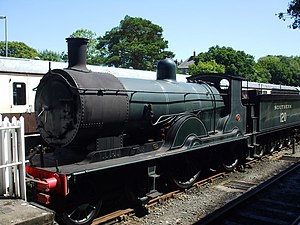LSWR T9 Class

Preserved 30120 on Bodmin and Wenford railway.
|
|||||||||||||||||||||||||||||||
|
|||||||||||||||||||||||||||||||
|
|||||||||||||||||||||||||||||||
|
|||||||||||||||||||||||||||||||
|
|||||||||||||||||||||||||||||||
| Type and origin | |
|---|---|
| Power type | Steam |
| Designer | Dugald Drummond |
| Builder | LSWR Nine Elms Works (35) Dübs & Co. (31) |
| Serial number | Dübs 3746–3775, 4038 |
| Build date | 1899–1901 |
| Total produced | 66 |
| Specifications | |
|---|---|
| Configuration: |
|
| • Whyte | 4-4-0 |
| Gauge | 4 ft 8 1⁄2 in (1,435 mm) |
| Leading dia. | 3 ft 7 in (1,092 mm) |
| Driver dia. | 6 ft 7 in (2,007 mm) |
| Length | 63 ft 9 in (19.43 m) |
| Loco weight | First batch: 46 long tons 4 cwt (103,500 lb or 46.9 t); second and third batches: 48 long tons 17 cwt (109,400 lb or 49.6 t) |
| Fuel type | Coal |
| Fuel capacity | 5 long tons 0 cwt (11,200 lb or 5.1 t) |
| Water cap | 4,000 imp gal (18,200 l; 4,800 US gal) |
| Boiler pressure | 175 lbf/in2 (1.21 MPa) |
| Cylinders | Two, inside |
| Cylinder size | 19 in × 26 in (483 mm × 660 mm) |
| Valve gear | Stephenson |
| Performance figures | |
|---|---|
| Tractive effort | 17,670 lbf (78.60 kN) |
| Career | |
|---|---|
| Operators | LSWR » SR » BR |
| Preserved | No. 30120 in National Collection |
| Disposition | One preserved, remainder scrapped |
The London and South Western Railway T9 class was a class of 66 4-4-0 steam locomotive designed for express passenger work by Dugald Drummond and introduced to services on the LSWR in 1899. One example has been preserved after British Railways ownership.
Intended for express passenger work in South-West England, 66 were eventually built and saw several improvements throughout their service careers. The class operated until 1963 when the last example,No 30120, was withdrawn. 30120 was preserved by the National Railway Museum, and is currently on long term loan to the Bodmin and Wenford Railway.
The design spawned from the relative failure of Drummond's C8 Class of 1898, utilising many lessons learned from this design. A larger boiler was implemented, and such confidence was placed in Drummond's design that an order of 50 locomotives was placed straight off the drawing board. Large fireboxes and Stephenson link valve gear ensured a free-steaming locomotive.
Construction was shared between the LSWR's Nine Elms Locomotive Works, London and Dübs and Company of Glasgow. Twenty were built at Nine Elms and 30 by Dübs. These were constructed between 1899 and 1900 and supplied with six wheel tenders. A second batch was ordered, and 15 more were constructed at Nine Elms, while a final, solitary example was constructed at Dübs and Company for the Glasgow Exhibition of 1901. Detail improvements on this final batch were a wider cab and revised wheel splasher that hid the 'throw' of the coupling rod, with cross-water tubes fitted into the firebox. This was an attempt to increase the heat surface area of the water, which was achieved, though at a cost in boiler complexity. This batch was also fitted with the Drummond "watercart" eight-wheel tender for longer running, whilst the previous was retrofitted with the design.
Upon Drummond's death in 1912, his successor, Robert Urie, supplied the class with superheaters, and from 1922, the entire class was so treated. Their sterling performance as a class precluded any further modifications, apart from the removal of the cross-water tubes, an enlarged smokebox, addition of a stovepipe chimney, and an increase of the cylinder bore to 19 inches (480 mm). These had been completed by 1929.
...
Wikipedia
